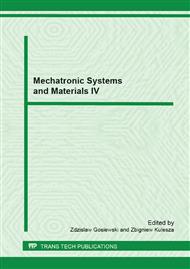p.388
p.394
p.400
p.406
p.412
p.421
p.427
p.433
p.439
The Temperature Influence on the Linear Actuator Static Parameters
Abstract:
The thermal field model of the linear oscillating actuator [5, has been presented in the paper. The calculated temperature has been taken into account to obtain the correct characteristics of the permanent magnets, which are operating in raised temperature (above 293 K). The parameters of the NdFeB magnets change significantly with temperature increasing (the magnets are weaker). Thus, the phenomenon should be included in the designing of the actuators. We have determined the highest current density of the actuator winding, for which the actuator still operates properly. Using the thermal field analysis, the temperature of the whole actuator construction has been obtained. Using the correct parameters of the hot magnets in the calculation model, the static electromagnetic parameters of the actuator have been determined. They were compared with those obtained for the actuator, which is operating in the room temperature (To=293 K). It has been proved, that the parameters of the actuator are going down under the increasing of the temperature.
Info:
Periodical:
Pages:
412-417
Citation:
Online since:
March 2013
Authors:
Price:
Сopyright:
© 2013 Trans Tech Publications Ltd. All Rights Reserved
Share:
Citation:


